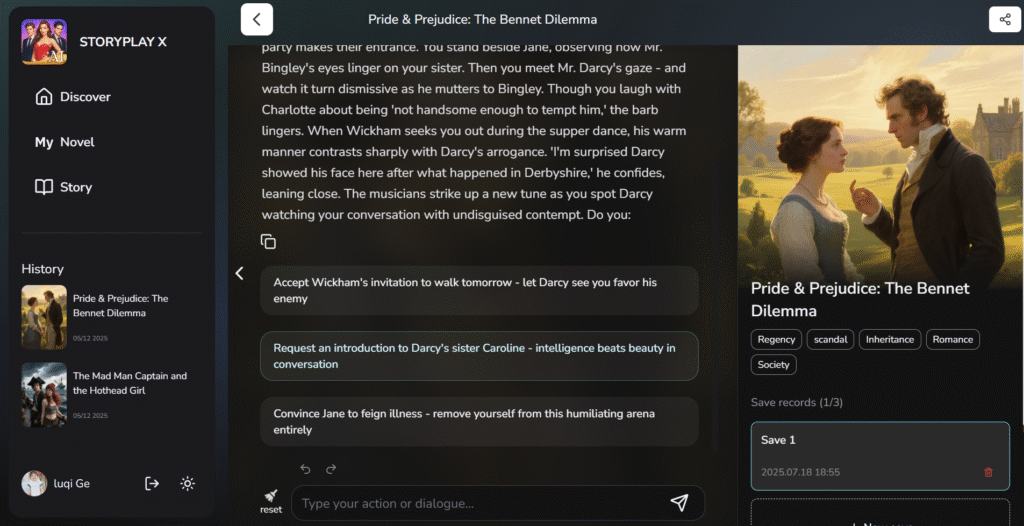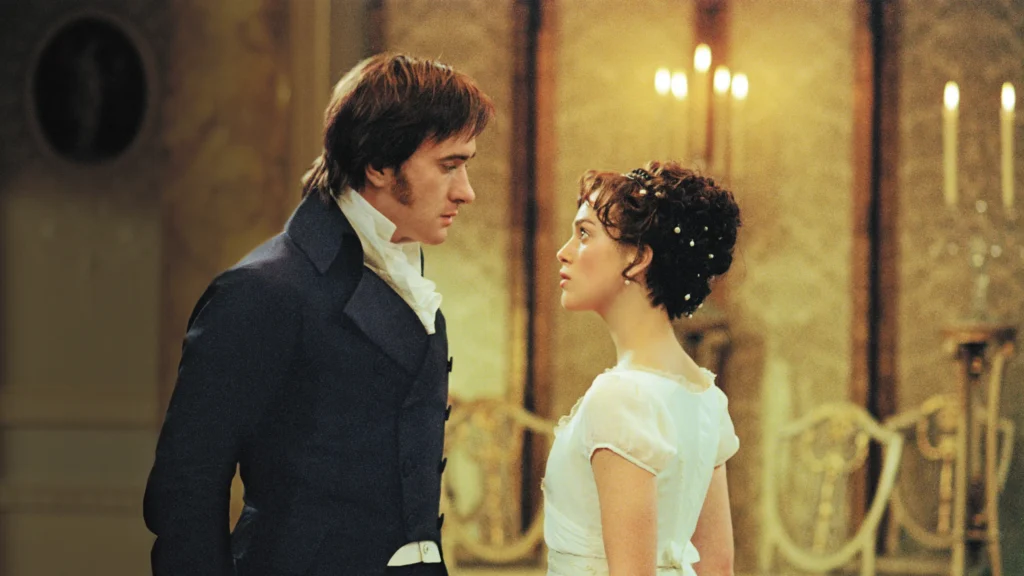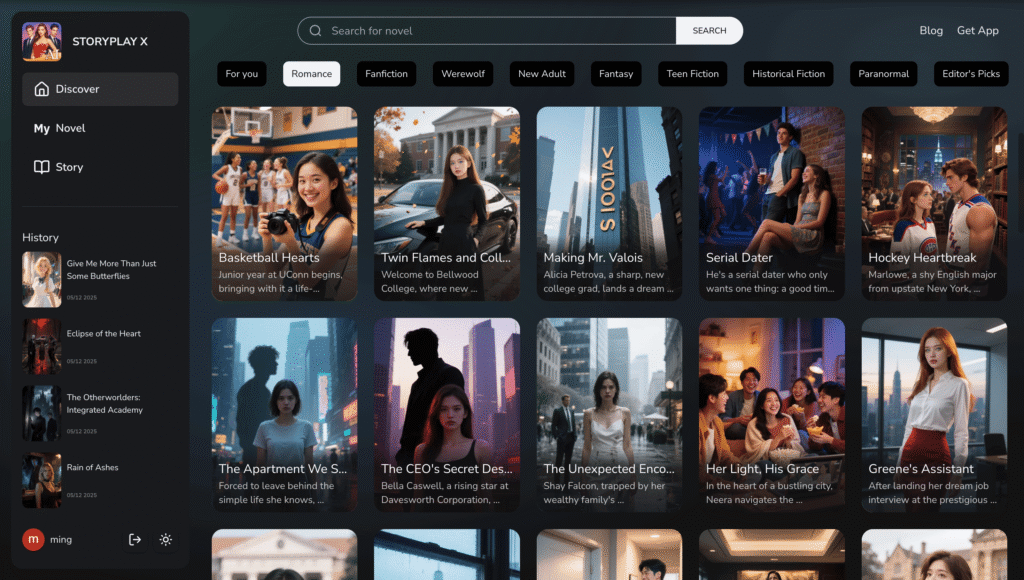Interactive Pride and Prejudice: How Storyplay X Lets You Rewrite the Classic Love Story
Table of Contents
What if Elizabeth Bennet had accepted Mr. Darcy’s first proposal? What if Jane spoke up about her feelings before Bingley left Netherfield? For over two centuries, readers of Jane Austen’s Pride and Prejudice have been asking “what if,” imagining alternative paths for beloved characters trapped forever in their printed pages.
Now, interactive Pride and Prejudice experiences on platforms like Storyplay X transform these centuries-old daydreams into reality. No longer must we merely witness Elizabeth’s journey—we can step into her shoes, make her choices, and discover where different decisions might lead in the complex social landscape of Regency England through interactive Pride and Prejudice adaptations.

The Eternal “What-Ifs” of Pride and Prejudice
Every devoted Austen reader harbors secret wishes about Pride and Prejudice. Perhaps you’ve longed to shake Jane from her reserve, preventing months of heartache. Maybe you’ve imagined Elizabeth seeing through Wickham’s charm immediately, or wondered how the story might unfold if she’d been less prejudiced during that first, fateful dance.
These aren’t mere modern musings. Since its 1813 publication, readers have penned countless letters, essays, and eventually fanfiction exploring alternative storylines. On platforms like Goodreads and literary forums, fans debate endlessly: Could Charlotte Lucas have found happiness beyond Mr. Collins? What if Lydia’s elopement had been prevented?These questions find answers in interactive Pride and Prejudice formats.
The interactive Pride and Prejudice experience answers these questions not through passive speculation, but through active participation. Each choice point in the narrative honors Austen’s careful character construction while opening new possibilities—because even the most perfect novel leaves room for imagination.

Stepping Into Elizabeth’s Dancing Shoes
The magic of interactive Pride and Prejudice begins with that first ball at Meryton. As Elizabeth, you face your first crucial decision: when Mr. Darcy stands aloof and declares you “tolerable, but not handsome enough to tempt me,” do you:
- Laugh it off with characteristic wit, setting the original story in motion?
- Confront him directly, perhaps sparking earlier understanding?
- Allow Charlotte to introduce you properly, bypassing the slight entirely?
Each choice ripples through the interactive Pride and Prejudice narrative. Accept Darcy’s eventual invitation to dance, and you might discover his social awkwardness masks deeper anxieties. Refuse more coldly than in the original, and watch how wounded pride compounds into something darker than mere prejudice.
The Storyplay X platform weaves these decisions seamlessly into Austen’s world. When Wickham arrives with his practiced charm and tragic tales, your Elizabeth must decide: believe his stories immediately, investigate independently, or perhaps notice inconsistencies Austen’s Elizabeth missed. Your choice shapes not just Elizabeth’s story, but determines whether Lydia faces ruin, whether Darcy must make his grand gesture, or whether entirely new conflicts arise.
Consider the visit to Pemberley—in an interactive Pride and Prejudice, this pivotal moment branches into fascinating possibilities. Do you flee upon hearing of Darcy’s imminent arrival? Stay but maintain distance? Or perhaps boldly acknowledge the awkwardness, leading to earlier honesty between the fractured pair? Each option opens unique narrative paths while maintaining the emotional truth of the original.

Four Paths Diverging in a Yellow Wood
The Independent Path
What if Elizabeth, glimpsing the restrictions marriage would bring even to a love match, chose independence? This interactive Pride and Prejudice storyline explores Elizabeth as a proto-feminist, using her wit and connections to establish herself in London’s literary circles. Watch her correspondence with Darcy evolve from romance to intellectual partnership, as both find fulfillment beyond traditional expectations.
The Wickham Revelation
In this interactive Pride and Prejudice branch, Elizabeth’s sharp intelligence pierces Wickham’s deceptions early. Without his lies poisoning her mind against Darcy, how does their relationship develop? Perhaps more slowly, built on genuine observation rather than dramatic revelation. Or perhaps Wickham, exposed, becomes a more dangerous antagonist, forcing Elizabeth and Darcy into earlier alliance.
The Great Switch
One interactive Pride and Prejudice path explores what readers on literary forums have long imagined: Jane falling for the complex, brooding Darcy while Elizabeth finds unexpected happiness with cheerful, uncomplicated Bingley. This isn’t mere character swapping—it’s a careful exploration of how different personalities might complement each other when initial circumstances change.
Imagine Jane’s gentle nature slowly thawing Darcy’s reserve, her goodness calling to his hidden kindness. Meanwhile, Elizabeth discovers in Bingley’s easy manners a restful counterpoint to her own intensity. The story explores different kinds of love—the slow burn of opposites attracting versus the comfortable warmth of aligned temperaments.
The Early Resolution
For those who find the original’s misunderstandings painful, this path offers earlier honesty. Elizabeth asks direct questions, Darcy explains without pride, and conflicts resolve through communication rather than dramatic revelation. Yet new challenges arise—how do two strong personalities navigate a relationship without the crucible of conflict to forge their understanding?
This version introduces external obstacles to replace internal ones. Perhaps Lady Catherine’s opposition comes earlier and fiercer. Maybe Wickham’s debts threaten the Bennet family directly. Or colonial connections bring new characters who challenge both Elizabeth and Darcy’s assumptions about class, race, and privilege in ways Austen only hinted at.
The Psychology of Interactive Classics
Why do we crave interactive Pride and Prejudice experiences? The answer lies in how we process beloved stories. Psychologists note that readers don’t simply consume narratives—we actively construct them in our minds, filling gaps with our own experiences and desires. Interactive fiction simply makes this natural process explicit.
When readers control Elizabeth’s choices in interactive Pride and Prejudice, they engage with questions of agency that Austen herself explored. How much can one woman determine her own fate within societal constraints? The Storyplay X format allows modern readers to test these boundaries, experiencing firsthand the weight of propriety, family duty, and economic necessity that shaped Regency women’s lives.
Moreover, interactive Pride and Prejudice serves educational purposes. Students struggling with the novel’s context gain visceral understanding when they must choose between financial security with Collins or uncertain spinsterhood. The interactive format transforms abstract historical knowledge into felt experience.
Why Interactive Enhances Rather Than Diminishes
Critics might argue that interactive Pride and Prejudice experiences tamper with perfection. Yet interaction doesn’t replace Austen’s vision—it illuminates it. By making choices as Elizabeth, readers understand more deeply why she acts as she does. The weight of decision reveals the constraints of her world more powerfully than passive reading.
Moreover, Storyplay X’s multiple endings increase rather than decrease appreciation for Austen’s choices. After exploring paths where Elizabeth remains unmarried or where early honesty prevents conflict, readers often return to the original with renewed admiration for its perfect balance of growth, conflict, and resolution.
The Art of Honoring While Reimagining
Creating interactive Pride and Prejudice content requires delicate balance. The language must echo Austen’s wit without becoming parody. Character growth must feel authentic to their established natures. New plot developments must arise organically from different choices, not forced drama.
This is where Storyplay X excels. Writers trained in both Austen scholarship and interactive narrative craft experiences that feel simultaneously fresh and familiar. Elizabeth’s voice remains true whether she’s accepting Darcy’s first proposal or explaining to her father why she chooses independence. The platform maintains Austen’s ironic narrative voice while allowing for player agency—no small feat.
The best interactive Pride and Prejudice adaptations understand that Austen’s genius lay not just in plot but in the delicate irony with which she exposed her society’s hypocrisies. Interactive versions must maintain this critical edge while allowing players to navigate—and perhaps challenge—those same social structures.

Your Pride and Prejudice Awaits
The beauty of interactive Pride and Prejudice lies not in replacing Austen’s masterpiece but in celebrating it through exploration. Each playthrough offers new insights into character motivations, social constraints, and the roads not taken. Whether you’re a first-time reader or can quote whole chapters, interactive adaptation offers fresh perspectives on beloved characters.
As Virginia Woolf wrote, “Jane Austen is the most difficult to catch in the act of greatness.” Perhaps that’s because her greatness lies not in single perfect choices but in understanding all the choices her characters might have made. Interactive Pride and Prejudice on Storyplay X doesn’t catch Austen’s greatness—it invites readers to participate in it.
Frequently Asked Questions
Do I need to read the original Pride and Prejudice first?
While prior knowledge enhances the experience, interactive Pride and Prejudice on Storyplay X includes enough context for newcomers. Many users actually find interactive versions help them understand and appreciate the original novel better.
How many different endings are possible?
Current interactive Pride and Prejudice adaptations on Storyplay X typically offer 8-12 distinct endings, with countless variations based on smaller choices throughout. Each playthrough takes approximately 2-3 hours, encouraging multiple explorations.
Will my choices affect other characters’ storylines?
Absolutely! Your decisions as Elizabeth ripple through the entire narrative. Prevent Lydia’s elopement, and Darcy’s grand gesture changes entirely. Encourage Jane’s boldness, and the Bingley subplot resolves differently. Every major character’s fate can shift based on your choices.
How faithful is the language to Austen’s style?
The Storyplay X adaptation maintains Austen’s distinctive voice through careful attention to period-appropriate dialogue and her signature ironic narration. Writers consult Austen scholars to ensure authenticity while crafting new scenes.
Ready to rewrite literary history? Discover how your choices might have changed one of literature’s greatest love stories. After all, it is a truth universally acknowledged that a classic novel in possession of devoted readers must be in want of an interactive Pride and Prejudice adaptation.
Further Reading:
Story Skeleton—Pride & Prejudice
Pride and Prejudice, explained in two charts
Jane Austen’s Pride and Prejudice at 200: looking afresh at a classic
